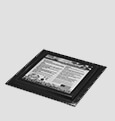Worm Factory® Standard Setup
Worm Factory® Standard Parts List:

1 Base Tray

1 Holding Tray

1 Collection Tray

Quick Tips Lid

3 to 5 Stacking Trays

Spigot & white
Spigot Nut

2 Steel Nuts &
2 Steel Bolts

Coir Brick

Shredded Paper
Worm Factory® Standard Assembly:
1. Place the holding tray over the base and align the grids. Locate the steel bolts and place them in opposite corners a few squares from the edge. Twist bolts by hand through the aligned grid until secure and screw on the nuts.
2. Place the collection tray into the holding tray and align the spigot holes.
3. Locate the spigot and the large white plastic nut. Insert the spigot through the holding tray and collection tray. Thread the plastic nut on the spigot inside the collection tray.
4. Place some water in the collection tray and check to make sure there is no leakage around the spigot. If there is, check the proper placement of the plastic nut and make sure it is firmly tightened. Remove the water from the base before continuing with assembly.
5. Set your first tray on the collection tray. You will start the vermicomposting process with just one tray. Set the others aside for later use.
6. Set the Quick Tips Lid in the tray. Now you are ready to add bedding, worms, and food!
Add Bedding:
1. Line the bottom of your first tray with 3 or 4 sheets of dry newspaper. You only have to do this on your very FIRST tray when you’re just starting out. When you first introduce your worms in to the vermicomposter, they will be stressed; stressed worms burrow downwards. This layer of newspaper prevents them from doing so at first. Once your worms get settled in their new home they will stay in their tray. Worms who do venture down into the holding tray will be able to crawl back up to their home on the worm ladder.
2. Place your coir brick in a bowl and pour 2 cups of water over it. Let it soak for a few minutes. Then, crumble off the loosened coir and save the solid part for later use. The loose coir should be moist but NOT sopping wet.
3. Mix the loose moist coir with ½ of the pumice and ½ of the shredded paper. Save the extra pumice and paper for later use. Place this mixture of bedding in your first tray, on top of the newspaper layer.
4. Add a few spoonfuls to a few cups of compost , garden soil, or leaf litter if available. This material contains organic organisms that will speed up the operation of your worm composter. This is optional.
5. Place a few handfuls of food (click here for suggested foods) in a corner of the tray.
6. Select a thick section of newspaper and soak it in a sink or with a garden hose. Let it drain a bit and then put this section on top of your bedding and food in the tray. When you feed in the future, you will put your food underneath this cover.
Add Worms
 Your vermicomposter is ready for worms! In most cases, worms are not included when you purchase your vermicomposter. When purchasing worms separately, make sure you buy the proper variety for composting: Eisenia fetida, or red wiggler worm. More information on composting worms here. It is recommended to start with a pound of worms, which is about 1000 animals. You can find worms here: www.findworms.com or buy them here at Nature’s Footprint Store
Your vermicomposter is ready for worms! In most cases, worms are not included when you purchase your vermicomposter. When purchasing worms separately, make sure you buy the proper variety for composting: Eisenia fetida, or red wiggler worm. More information on composting worms here. It is recommended to start with a pound of worms, which is about 1000 animals. You can find worms here: www.findworms.com or buy them here at Nature’s Footprint Store
1. To add your worms, remove them and their bedding material from the package they arrived in. Remove the lid of your vermicomposter and lift up the moist newspaper cover. Place your worms and their bedding on the prepared bedding in your tray, and replace the moist newspaper cover and the lid.
2. It is important to realize that when your worms arrive, they will be stressed and may take a week or so to adapt to their new environment. You can leave a light on at night (if indoors) for a few days to encourage them to burrow into their new home.
3. After a few days, check on your worms. Lift the moist newspaper cover and see if your worms are engaged in the food waste. If not, recover it and wait a few more days. If they are engaged in the food waste, then it’s time to add more food. Add a few more handfuls of food and replace the newspaper cover and lid.
4. A common mistake is to overfeed at the very beginning. A general rule of thumb is: if previous food is untouched, don’t add new food. If previous food is being consumed, add some new food. If previous food is gone, feed at a higher rate.
